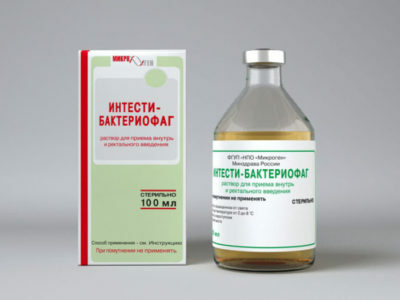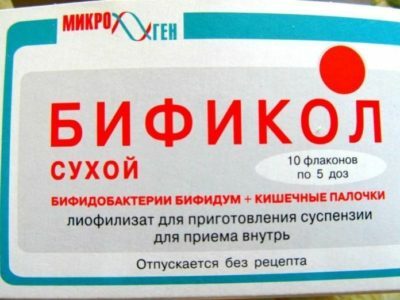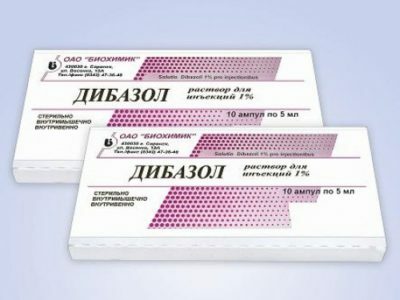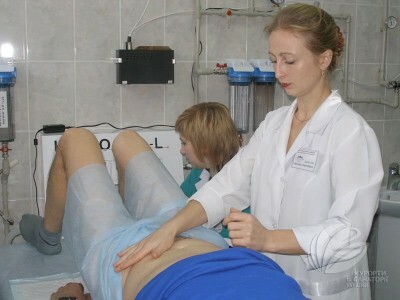1 Scheme for the treatment of
Disease treatment of adult intestinal dysbiosis is carried out in stages and begins with the elimination of the causes that caused imbalance. Normalization of nutrition, lifestyle correction, revision of methods of treatment of systemic diseases - the initial stage of preparation for the treatment of dysbiosis. Directly the scheme of treatment of a dysbacteriosis consists of several stages:
- application of the medical preparations directed on destruction of pathogenic microorganisms;
- colonization of the intestine by microorganisms included in the normal microbiocenosis;
- achievement and preservation of the balance of natural microflora;
- restoration of intestinal functions;
- strengthening of the immune status of the body.
In each case, an individual approach to the choice of a drug is proposed, which depends on the composition of the pathogenic and the amount of endogenous microflora.
2 Antibiotics and bacteriophages
In order to purify the intestines from pathogens, antimicrobial and antimycotic drugs are used.
Antimicrobial agents include antibiotics of various groups:
- tetracycline - Tetracycline, Minocycline, Doxycycline, Vibramycin, Doxal, Tetradox, etc.;
- penicillin - Amoxicillin, Flemoxin Solutab and others;
- cephalosporin - Cefoperazone, Ceftir, Cefofibiprol, Cefotaxime and others;
- quinolone group - Gemifloxacin, Sitafloxacin, Moxifloxacin, Ciprofloxacin, Lomefloxacin and others;
- aminoglycosides - Amikacin, Fartsiklin, Neomycin, Garamycin and others;
- Metronidazole;
- Rifaximin;
- Alpha Normix, etc.

Recommended to read
- Than to treat intestinal dysbiosis in adults
- Preparations with lactobacilli for intestines
- Treatment of intestinal dysbacteriosis
- Effective agent for gastritis and stomach ulcer
Antimicrobials may aggravate dysbiosis, reducing the amount not only pathogenic but also endogenousmicroflora. Therefore, antibiotics are prescribed either selective actions that purposefully destroy certain types of pathogens, or when the intestinal suction and motor function is disturbed, characterized by the growth of pathogenic microbes in the cavity of the small intestine. With dysbiosis of the large intestine used drugs: Intetrix, Nitroxoline, Ersefuril, etc. These drugs effectively destroy staphylococci, yeast fungi and proteins, without having a significant effect on natural biocenosis.
-
 IMPORTANT TO KNOW! Gastritis? Ulcer? To have a stomach ulcer not turned into cancer, drink a glass. ..Read the article & gt; & gt;
IMPORTANT TO KNOW! Gastritis? Ulcer? To have a stomach ulcer not turned into cancer, drink a glass. ..Read the article & gt; & gt;
For staphylococcal infection that causes dysbacteriosis, they are treated with: Oxacillin, Nevigramon, Co-Trimoxazole, Tarivid, Palin, etc.
Generally cephalosporins III and IV are given, with fewer side effects than their predecessors. The course of antibiotic use should not exceed 5-7 days. Dosage is calculated individually.
Sorbents, such as Polysorb, Enterosgel, White Coal, Filtrum-STI, etc., are being used to remove from the body the degradation products of pathogenic microorganisms, their toxins and other results of vital activity,
Currently, the preparations of living animals are becoming increasingly popular in the treatment of intestinal dysbacteriosisbacteriophages. They are represented by several kinds of bacteria parasitizing inside bacterial cells, which leads to the death of pathogenic microbes. In nature, bacteriophages are natural regulators of the number of pathogens.
-
 Gastroenterologist IMPORTANT: "I beg you, if you began to worry about abdominal pain, heartburn, nausea, do not do gases. .."Read more & gt; & gt;
Gastroenterologist IMPORTANT: "I beg you, if you began to worry about abdominal pain, heartburn, nausea, do not do gases. .."Read more & gt; & gt;
Bacteriophages are produced in different pharmacological forms. The name of the drug corresponds to that pathogenic organism in which the bacteriophage parasitizes. So, already there are pseudomonadal, staphylococcal, dysentery and streptococcal phages. Drugs can contain only one of the strains of bacteriophages: Salmonella, Coli-bacteriophage, Proteus bacteriophage, Pseudomonas bacteriophage, etc. Complexes containing several bacteriophage types are also available: Intesti, Pyobacteriophage polyvalent, Sextafag, etc. Drugs are an effective and safe alternative to antibiotics.

3 Prebiotics with probiotics and symbiotics
The next stage in the fight against dysbacteriosis is colonization of the intestine with strains of microorganisms of the natural microflora. For this, the following are used:
- prebiotics;
- probiotics;
- symbiotics.
Probiotic preparations consist of living organisms that exert a stabilizing and optimizing function on the natural intestinal microflora. They are divided into:
- Multicomponent( Linex, Bifikol, Bifiform), which includes a complex of useful microorganisms - colibacillus + bifidobacteria + lactobacillus.
- Single-component( Bifidumbacterin, Lactobacterin, Colibacterin).From the name of the medicine it becomes clear which strain is included in the composition.
- Combined( Rioflora immuno, Bifikol, Florin Forte, etc.) is a complex of bacteria not susceptible to antibiotics, stimulates the growth of natural microflora.
ADVICE FROM THE MAIN GASTROENTEROLOGIST
Korotov SV: "I can recommend only one remedy for the rapid treatment of Ulcer and Gastritis, which is now recommended by the Ministry of Health. .." Read testimonials & gt; & gt;

Probiotics contain high doses of microorganisms, so people with severe forms of immunodeficiency or prone to allergic reactions before eating eubiotics should consult a doctor. Some kinds of probiotics can not be combined with taking antibiotics, as they reduce the effectiveness of eubiotics.
Prebiotics are preparations in which certain substances undergo fermentation in the large intestine and fermentation products stimulate the growth of useful microflora of the large intestine. Stimulation is selective, mainly prebiotics stimulate the vital activity of bifidobacteria and lactobacilli.
Prebiotic drugs include: Norma, Goodluck, Dufalac, Laktusan, Exportal, Bifiliz, etc. BADs with the same action are produced: Prelax, Laktusan, Maksilak, etc. Since prebiotics are part of a food product that is not absorbed by the body,they do not cause side effects and can be used not only for treatment, but also for preventive purposes.

Symbiotics are drugs in which probiotics and prebiotics are rationally combined. Prebiotics help probiotics pass through areas of the intestine with an aggressive environment, and then, as a nutrient substrate, it is possible to colonize the distal parts of the digestive system with a useful microflora. The group of symbiotics includes: Bifidobac, Laminolact, Maltidofilus, etc.
The course of drugs is 14 days for pre and prebiotics and 21 days for symbiotics. Despite the safety and naturalness of the drugs, they must be used according to the doctor's prescription and in the dosage prescribed by him.
4 Immunomodulators and biostimulators
The next step is to increase the immune properties of the body. Obligatnaya microflora synthesizes immunoglobulins, affects the functions of the immune system. With dysbacteriosis, natural microorganisms are replaced by pathogenic and opportunistic pathogens, which affects the level of the body's defenses. Immunomodulating drugs are used to increase immunity: Dibazol, Immunal, etc. It is effective and safe to use propolis tincture, Eleutherococcus, Echinacea, etc.

5 Symptomatic therapy
For the normalization of bowel functions, drugs prescribed by the gastroenterologist are used. It is necessary to show the use of vitamin complexes and microelements. Also, a number of drugs are used to reduce the symptoms of the disease:
- with diarrhea use antidiarrheal drugs - Attapulgite, Bactisubtil, Bifikol, Gastrolit, Diosmectit, Intetriks, etc.;
- for the treatment of constipation - Lavakol, Fortrans, Transipeg, Senalex, Guttalax, Glyselax, etc.;
- antispasmodics for relaxation of bile ducts - No-sppa, Duspatalin, etc.;
- cholagogue preparations - Hofitol, Allochol, Peridol, Chagolol, Tanacesole, etc.;
- enzymatic - Creon, Mezim, Festal, etc.
All medications should be taken according to the instructions, individual recommendations and observance of the scheme.
The most common medicine for dysbiosis is probiotics and prebiotics. Other types of drugs are prescribed in the event of serious damage to the body as a result of dysbiosis and its severe forms.
With intestinal dysbacteriosis, it is important to maintain dietary intake, as some foods complicate the action of drugs or make it difficult for the intestine.
Treatment of dysbacteriosis should begin when the first symptoms of the disease appear. If the condition is not amenable to nutrition correction, then it is necessary to consult a gastroenterologist and begin the recommended treatment. In the initial stage, the system of the organism's biocenosis is quickly restored. In a neglected state, dysbacteriosis is treated much longer and more difficult.
- 1 Treatment regimen
- 2 Antibiotics and bacteriophages
- 3 Prebiotics with probiotics and symbiotics
- 4 Immunomodulators and biostimulators
- 5 Symptomatic therapy
When treating intestinal dysbiosis in adults, the drugs and regimens that are used for this purpose have characteristic differences and are designed to restore microflora. In the human intestine, the microbiocenosis consists of 2500 species of various bacteria that are in dynamic equilibrium and are included in the vital activity of the organism. Violation of this balance is a dysbiosis. When the balance is disturbed, not only the processes of transformation and absorption of food undergo changes, but the effectiveness of immune processes also decreases. There are differences in the composition of the intestinal microflora in adults and children due to physiological development.
Do you have gastritis?
GALINA SAVINA: "How easy is it to cure gastritis at home for 1 month. A proven method is to write down a recipe. ..!"Read more & gt; & gt;



